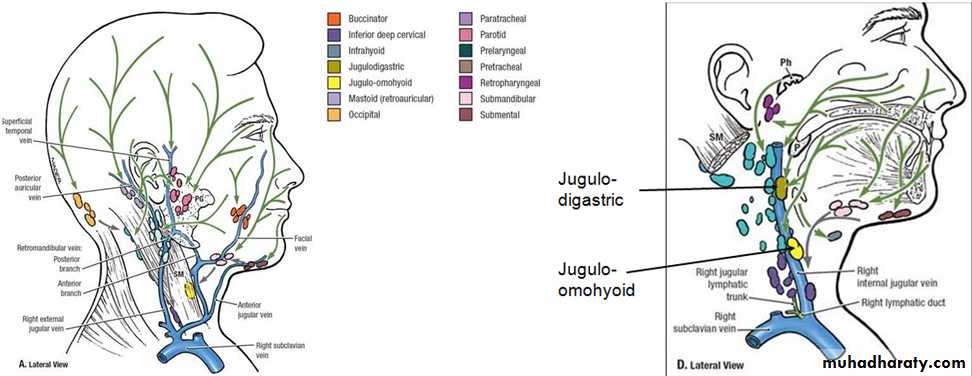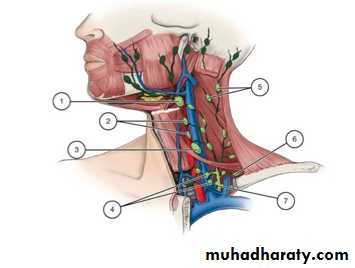LYMPHATIC SYSTEM OF THE HEAD AND NECK
LYMPHATIC SYSTEM: includes lymph nodes and lymph vessels.The lymph nodes of the head and neck are very numerous, and fall into two sets:
• Horizontal groups• Vertical (cervical) groups
1. HORIZONTAL GROUPS
They are situated around the junction of the head with the neck, and drain all the superficial structures of the head and some deep parts.They are assisted in the drainage of the deeper structures by nodes situated posterior to the pharynx.
Most of the efferent vessels from these groups pass to the vertical group.
2. VERTICAL (CERVICAL) GROUPS
These consist of a vertical chain composed of numerous superficial and deep nodes.1. HORIZONTAL GROUPS
• Occipital lymph nodes• Mastoid (postauricular) lymph nodes
• Parotid and preauricular lymph nodes
• Submandibular lymph nodes
• Submental lymph nodes
• Retropharyngeal lymph nodes
1. Occipital lymph nodes
These are a few small nodes that lie on the upper end of trapezius and on the fascia at the apex of the posterior triangle.They drain the occipital part of the scalp and the superior part of the back of the neck.
2. Mastoid (postauricular or retro-auricular) lymph nodes
These nodes lie on the superior end of the sternocleidomastoid posterior to the auricle.They drain the posterior half of the side of the head and the posterior surface of the auricle.
3. Parotid and preauricular lymph nodes
These are several small nodes which are scattered throughout the parotid gland from its lateral to its medial surface.
They drain a great part of the head, including the anterior part of the scalp, the upper half of the face, the upper molar teeth and gums, the temporal and infratemporal regions, the auricle, the external acoustic meatus, the middle ear and auditory tube, and the lacrimal and parotid glands.
4. Submandibular lymph nodes
These nodes lie along the length of the submandibular salivary gland, in the groove between the mandible and the gland.They drain the lower part of the front and side of the face (including the lower lip and chin) from the submandibular and sublingual salivary glands, from the floor of the mouth, the side of the tongue, most of the teeth and gums, part of the palate and the anterior part of the walls of the nasal cavity.
5. Submental lymph nodes
Three or four small nodes lie between the anterior bellies of digastric on the fascia covering the inferior surface of mylohyoid.They drain lymph from a wedge-shaped zone which includes the incisor teeth and gums, and the anterior part of the floor of the mouth.
6. Retropharyngeal lymph nodes
A few nodes lie in the fascia on the posterior wall of the upper pharynx, in a plane just anterior to the mastoid process.They drain lymph from the oral and nasal parts of the pharynx, the palate, nose, and air sinuses, the auditory tube and middle ear.
2. VERTICAL GROUPS
• Superficial cervical lymph nodes• Deep cervical lymph nodes
1. Superficial cervical lymph nodes
2 groups:• 1st group arranged along the
• external jugular vein.
• anterior jugular vein.
• A. The external jugular vein group drain the adjoining skin and the parotid nodes, and send lymph vessels around the anterior border of sternocleidomastoid to the deep nodes in the carotid triangle.
B. the anterior jugular vein group are few in number and receive lymph from the skin and muscles of the anterior part of the neck, and transmit it to the deep nodes.
2. 2nd group lies in the posterior triangle and arranged along the anterior border of trapezius.
2. Deep cervical lymph nodes
Composed of nodes that are arranged along the internal jugular vein from the digastric to the root of the neck, and drain tongue and the structures in the neck.These are numerous and large, and they form a broad strip of nodes.
Two of them, the jugulodigastric and the jugulo-omohyoid, are of special importance in the lymph drainage of the tongue and are named from their relation to the digastric and omohyoid muscles.































